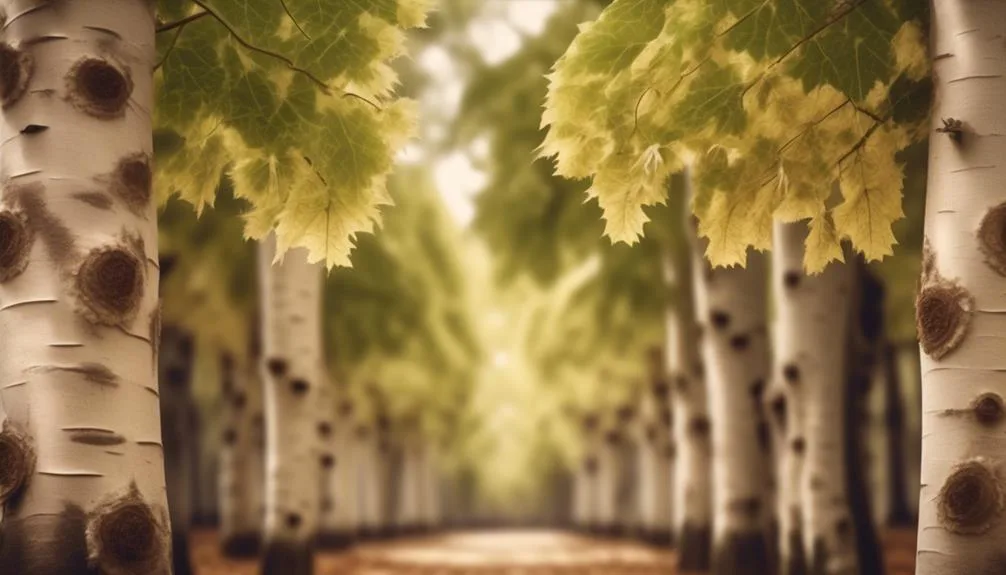Choosing the right sycamore tree variety is like finding the perfect outfit – you want it to fit well and leave a lasting impression. With numerous options available, it can be overwhelming. We're here to guide you through the world of sycamore trees.
Whether you want shade, a beautiful landscape, or simply love these trees, there are key factors to consider. By the end, you'll have the knowledge to make a well-informed decision that suits your needs.
Consider Local Climate and Soil
When choosing a sycamore tree variety, it's essential to consider your local climate and soil to ensure the tree thrives in its environment. Sycamore trees have different preferences when it comes to climate, with some varieties being more tolerant of heat or cold than others. Before making a selection, research the specific climate requirements of the sycamore tree varieties you're considering.
Additionally, soil composition plays a crucial role in the health and growth of sycamore trees. Some varieties prefer well-drained soils, while others can tolerate a variety of soil types. Understanding your local soil composition will help you choose a sycamore tree variety that will adapt well to the conditions in your area and flourish for years to come.
Evaluate Size and Growth Rate
To select the right sycamore tree variety for your landscape, consider the mature size and growth rate of each option to ensure it fits your space and maintenance preferences.
Sycamore trees generally have a vigorous growth rate, making them ideal for landscaping projects that require quick establishment. However, it's crucial to evaluate the potential size of the tree at maturity to ensure it won't overcrowd your space or interfere with structures.
Additionally, consider the root system of the sycamore variety you choose, as some varieties have more aggressive roots that may require more maintenance to prevent issues with sidewalks, driveways, or underground utilities.
Furthermore, sycamores are known for their impressive shade provision, so selecting a variety that aligns with your desired level of shade is also essential for your landscaping plans.
Examine Bark and Leaf Characteristics
Examining the bark and leaf characteristics of sycamore tree varieties will provide valuable insights into their aesthetic appeal and potential impact on your landscape.
The bark texture of sycamore trees varies widely, with some species displaying smooth, pale bark while others exhibit a striking mottled pattern of brown and white.
Additionally, the leaf shape of sycamore trees can greatly influence their overall appearance. Some varieties feature large, broad leaves with deep lobes, creating a lush, dense canopy, while others have more slender, dainty leaves that impart a delicate and airy feel to the tree.
Considering the bark texture and leaf shape is crucial in selecting a sycamore tree variety that aligns with your desired visual effect and complements the existing vegetation in your outdoor space.
Compare Disease Resistance
You can assess the disease resistance of different sycamore tree varieties by observing their ability to withstand common ailments such as anthracnose and powdery mildew. Resistance testing involves researching and selecting varieties known for their ability to resist these diseases.
When comparing disease resistance, consider the specific planting location. For instance, if you live in an area prone to anthracnose, it's crucial to choose a variety with a high resistance to this particular disease. Similarly, if powdery mildew is prevalent in your region, opt for a variety that has shown strong resistance to this condition.
Assess Aesthetic Appeal
When evaluating sycamore tree varieties for their aesthetic appeal, consider the unique foliage and bark characteristics that contribute to their visual allure.
Sycamores offer a stunning display of color variations throughout the year, from vibrant greens in spring and summer to rich golden and bronze hues in the fall.
The leaf shape is another important factor to assess, as it varies between species, ranging from broad, lobed leaves to more slender, pointed ones.
Additionally, the mottled and exfoliating bark of certain sycamore varieties adds an intriguing visual element to the landscape.
Observing these aesthetic features will help you select a sycamore tree variety that not only suits your landscape but also adds visual interest and beauty to your outdoor space.
Conclusion
Considering your local climate, soil, tree size, growth rate, bark and leaf characteristics, disease resistance, and aesthetic appeal is crucial when choosing a sycamore tree variety.
These factors will ensure the tree thrives in your outdoor space, enhancing your landscape for years to come.
Happy planting!
Mark Hoffman is a dedicated arborist and tree care specialist with over a decade of experience. His love for trees began when he visited Yosemite National Park as a teenager and was awestruck by the giant sequoias. Mark pursued his passion by studying forestry at Michigan Technological University, where he earned a Bachelor of Science degree.
Since then, he has worked tirelessly in the field of arboriculture, helping to preserve and protect trees in his community. His expertise and dedication have made him a respected leader in the industry and a valuable resource for anyone seeking advice on tree care.
